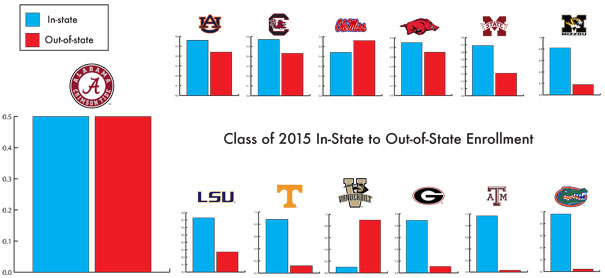 When the University of Alabama class of 2012 first arrived on campus in the fall of 2008, 63 percent of its members were from the state of Alabama. Most of the members of the class of 2015, which arrived on campus last fall, are not.
When the University of Alabama class of 2012 first arrived on campus in the fall of 2008, 63 percent of its members were from the state of Alabama. Most of the members of the class of 2015, which arrived on campus last fall, are not.
Slightly more than 50 percent of the students who walked on campus as freshman at the beginning of the academic year were from other states or foreign countries. The increasingly large percentage of out-of-state students attending Alabama has set the University apart from other Southeastern Conference schools.
At the University of Mississippi, 55 percent of freshmen are out-of-state students, according to university spokesman Mitchell Diggs. Ole Miss is the only public college in the conference with a higher percentage of out-of-state freshmen than Alabama.
“I think that bringing out-of-state students provides different and new perspectives,” said A.J. Collins, a junior majoring in economics and political science from Virginia. Collins is the president of the Honors College Ambassadors, which works to recruit high-achieving students from across the country.
“Having students with a variety of geographic diversity will allow us to come up with new ideas with people from different parts of our country working together,” he said.
According to the common data set most universities report annually, Auburn comes in third among public schools in the conference, with an out-of state freshman class of 44 percent. At the other end of the spectrum, only four percent of freshmen at the University of Florida are out-of-state this year.
Vanderbilt, the only private university in the SEC, 89 percent of the freshman class is out-of-state.
Out-of-state students bring the University more than new perspectives, though, as they pay much higher tuition rates than in-state students. For Spring 2012, tuition for out-of-state students is $10,950, over two-and-a-half times the $4,300 in-state students pay.
Higher numbers of higher-paying students has helped the University absorb the impact of stagnant appropriations from the state. State appropriations made up 29 percent of the University’s revenue in 2003, but now, they make up only 20 percent.
The same trend is occurring across the United States. Tuition grew from 16 percent of revenue at public universities in 1999 to 26 percent in 2009, a Government Accountability Office report released in January found. Colleges have looked to tuition dollars for revenue as state appropriations have been cut and income from endowments and private gifts have declined, the report found.
But many out-of-state students are able to reduce their tuition with scholarship money.
“Paying full tuition as an out-of-state student is really out of the question for most people, and it was for me as well,” said Colby Leopard, a junior majoring in public relations from North Carolina. Leopard has helped recruit out-of-state students through the Student Alumni Association.
“When it comes to recruitment, the advantage Alabama has is that it has money to offer,” Leopard said. Out-of-state high school seniors who apply to Alabama by December 1of their freshman year, have a GPA of 3.5 and score a 30 on the ACT receive a scholarship equal to two-thirds of tuition over four years. Applicants with an ACT score of 32 or higher receive full tuition. The same scholarships are available to National Merit Semifinalist, and National Merit Finalists also receive four years of on-campus housing and an iPad.
But Leopard said the University offers students other benefits that make it more attractive than other large, state universities.
“It also goes back to things like the dorms. I know that the dorms here are not something that a lot of out-of-state students would find in their own states,” he said.
He also said the University gives students easy access to professionals in different research areas and has maintained a family atmosphere despite its growth.
“You’re still going to feel at home,” he said.
Alabama
In-state: 19,868
Out-of-state: 10,663
Foreign: 1,185
Not reported: 31
Total: 31747
2010-2011 Out of State freshman: 42.8 (3rd) Undergraduates: 31% 24,882 (4th) 7,713
2002-2003 Out of State freshman: 22.7% Undergraduates 19.70% 15,441 3,505
9,441 4,208
44% of student growth out of state students
Class of 2015: Just over 50%
Auburn
24,393
14,674 (in-state)
9719 (out of state)
1,076 (foreign)
25469
Out-of-state: 39%
Freshman out-of-state: 45%
Class of 2015 44%
OIRA –
334-844-4765
Cara Mia Braswell
Jenna Johnson
South Carolina
Out-of-state: 32%
Freshman out-of-state: 42%
Class of 2015 out of state: 43%
University of Mississippi:
Total enrollment: 35.9%
Out-of-state: 32%
Freshman out-of-state: 48%,
3, 516
44.7%; 5
Class of 2015 out of state: 55.3%
Mitchell Diggs
University of Arkansas:
Out-of-state: 30%
Freshman out-of-state: 38.6%
Class of 2015 out of state: 44.8%
Vanderbilt:
Class of 2015 out of state: 89%
University of Missouri:
Out-of-state: 28%
Freshman out-of-state: 18%
Mississippi State:
Out-of-state: 21%
Freshman out-of-state: 31%
Class of 2015 out of state: 31%
Out-of-state: 20%
Freshman out-of-state: 24%
Class of 2015 out of state: 26%
Louisiana State University:
Out-of-state: 19%
Freshman out-of-state: 27%
Tennessee:
Out-of-state: 14%
Freshman out-of-state: 12%
Georgia
27,667 (in-state)
34,816 (total)
Out-of-state: 9%
Freshman out-of-state: 12%
Class of 2015 out of state: 11%
Texas A&M University:
Out-of-state: 3%
Freshman out-of-state: 3%
Florida
Out-of-state: 2.5%
Freshman out-of-state: 3%
Class of 2015 out of state: 4%









